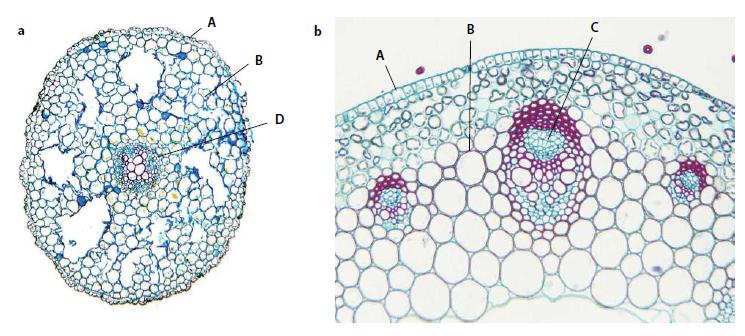For this question you need two sheets of graph paper. The light micrographs below are a a
Question:
For this question you need two sheets of graph paper.
The light micrographs below are a a cross section of a young root, and b a representative part of a young stem of Ranunculus (buttercup).

a. Name the tissues A, B, C and D.
b. i. On one of the sheets of graph paper, draw the outline of the root. Use at least half the width of the graph paper when making your drawing.
Now draw inside your outline a low-power plan of the xylem only. Be as accurate as you can in drawing the correct proportions compared with the overall size of the root – you may find it useful to make some measurements with a ruler.
ii. Now take the second sheet of graph paper and draw the outline of the stem. It does not have to be exactly the same size as your drawing of the root. Carefully make a low-power plan to show the vascular bundles only. Draw in outline the lignified tissues sclerenchyma and xylem, and the tissue labelled C between them.
iii. Sclerenchyma and xylem are tissues which contain dead cells whose walls are thickened with a mechanically strong substance called lignin. Lignin is used for strength and support. Count the number of squares of graph paper covered by lignified tissue (xylem) in the root. Count the squares that are more than half included in the drawing as whole squares, and do not count squares that are less than half included.
iv. Count the number of squares covered by the whole root section (including the lignified tissue).
v. Calculate the percentage of squares occupied by lignified tissue in the root as follows:

vi. Repeat steps iii to v for the stem (remember lignified tissue in the stem is sclerenchyma plus xylem).
vii. Assuming the results you have obtained are typical of the whole stem, suggest an explanation for the difference in percentage of lignified tissue in the root and the stem.
c. If you try to imagine these structures in three dimensions, the lignified tissue in the root is a central rod, but in the stem it is a circle of separate rods. Suggest the reasons for the different distribution of lignified tissues in the root and the stem.
Step by Step Answer:

Cambridge International AS And A Level Biology
ISBN: 9781107636828
4th Edition
Authors: Mary Jones, Richard Fosbery, Jennifer Gregory, Dennis Taylor




